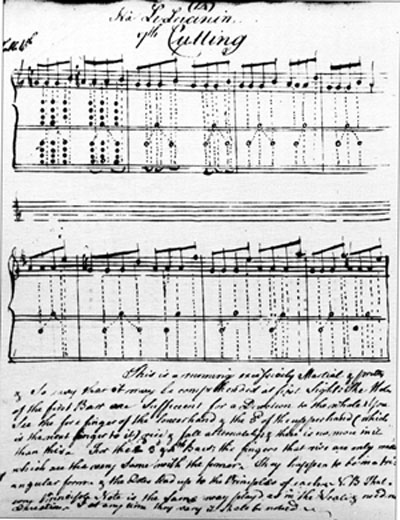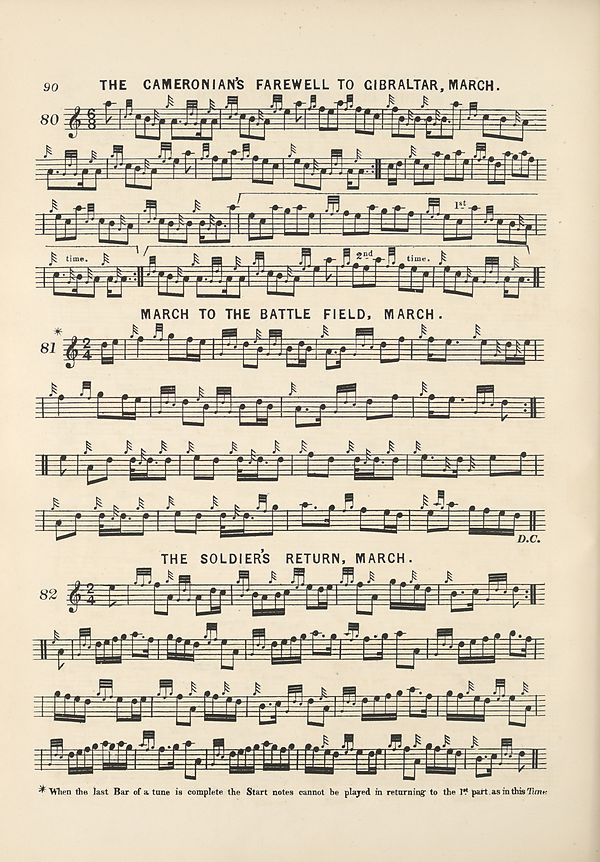|
-
23rd May 17, 05:32 AM
#13
 Originally Posted by slothead

I have never seen pipe music so is it written much like any music (piano or otherwise) with staffs, clefs, notes and rests, or is it peculiar to the pipes?
That question, as alluded to above, is more complicated that it might seem.
The basic answer is "yes", it is written much like normal music with staffs, clefs, and notes. What you don't have is rests, because the pipes sound continuously.
Pipe music has been set down in ordinary staff notation since the mid-18th century at least, here in 1760:

The Highland Society of London has manuscripts of piobaireached in staff notation from the beginning of the 19th century.
Later in the 19th century a large number of books of pipe music in staff notation were published. The large pipemaking family Glen published many collections starting in 1840.
Here is a page from the Ross Collection (1869). Note the typical pipe ornaments and the lack of key signature.

From the second half of the 19th century onward to today the Highland pipe scene is dependent on published music, to an almost obsessive degree.
For example, here's a track listing from a CD of The World Pipe Band Championships:
10. Medley
Poacher's Paradise (R Durrant- Focus Music LTD)
The Curlew (Trad-PD)
The Old Wife Of The Mill Dust (Trad-PD)
Classical Bob (N Dickie arr R Mathieson-Isa Music)
Maggie Cameron (Trad-PD)
Mrs Donald MacPherson (D MacPherson-D MacPherson)
Wee Harry's Reel (A Mathieson-Cop Con)
The Gravel Walk (Trad-PD)
So the traditional Public Domain stuff is listed as such. Newly composed stuff (which often makes up the majority of the repertoire of modern Pipe Bands) gives the composer, arranger, and publisher.
The interesting thing is the "Cop Con" (copyright control) meaning the composer isn't represented by a publisher.
About the way pipe music is written, up until recently it was common to leave off the Key Signature, which is two sharps.
Since pipers in the old days stuck to the traditional 9-note diatonic scale putting in the key signature was superfluous.
Nowadays the key signature is nearly always used, which has been driven by two things
1) the using of computer programmes which read literally what is on the page, and if you leave out the key signature the computer plays all the Fs and Cs natural.
2) numerous modern compositions using the chromatic possibilities of the Highland chanter, which require that all the sharps and naturals be correctly notated.
So, any fiddler or whomever can sightread any piece of modern pipe music and play it more or less the way the pipes would play it.
Then there are all the ornaments. Usually when pipe tunes are played by fiddle, accordion, or whatnot the ornaments are left out, or sometimes an analogous ornament more suited to the particular instrument is used.
The Highland pipe classical music, Ceol Mor or Piobaireached, has all sorts of complex ornaments. Here are a few. These don't translate to any other instrument, seems to me.

(Odd that they put in a key signature of one sharp, probably because these examples don't happen to have any Cs.)
Two things to keep in mind are Key, and Pitch.
The Highland pipe chanter is in the key of B flat Mixolydian (or E flat Major if you prefer) giving the notes
Ab Bb C D Eb F G Ab Bb
however pipe music has always been written a semitone lower, in A Mixolydian (D Major)
G A B C# D E F# G A
So Scottish Smallpipes in A play normal Highland sheet music at pitch, while the Highland pipes play it a semitone higher. Guitarist usually use a capo at the first fret when playing with the Highland pipes.
The other issue is pitch.
When I started playing, in the 1970s, Highland pipe chanters were pitched around Concert Pitch, Concert B flat. It's great for playing with Pipe Organ, or brass ensembles, or orchestras, or rock bands, or what have you.
Then around 1980 the pitch began creeping gradually upwards, and it may keep creeping up, who can say. Currently most pipe bands play at a pitch which is more or less a quartertone between B flat and B natural, decidedly unfriendly for playing with other musicians.
So, nowadays chanters are available in modern pitch and in Concert Pitch/Concert B flat. Many solo pipers and quite a few pipe bands maintain chanters at both pitches, the sharp ones for playing in pipe competitions and the flat ones for playing gigs with orchestras etc.
Last edited by OC Richard; 23rd May 17 at 05:51 AM.
Proud Mountaineer from the Highlands of West Virginia; son of the Revolution and Civil War; first Europeans on the Guyandotte
-
The Following User Says 'Aye' to OC Richard For This Useful Post:
 Posting Permissions
Posting Permissions
- You may not post new threads
- You may not post replies
- You may not post attachments
- You may not edit your posts
-
Forum Rules
|
|


















Bookmarks